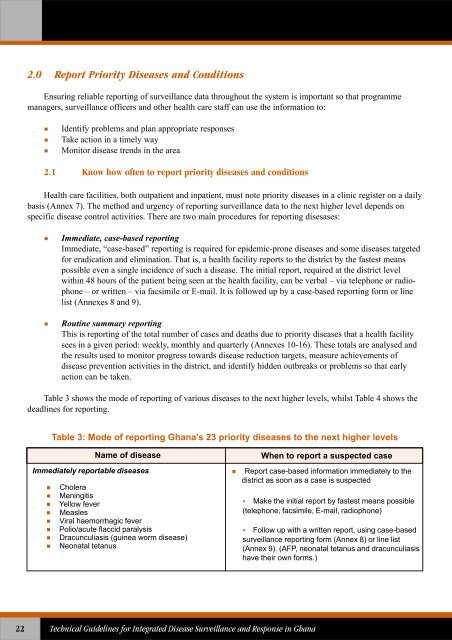Technical Guidelines for Integrated Disease Surveillance ... - PHRplus
Technical Guidelines for Integrated Disease Surveillance ... - PHRplus
Technical Guidelines for Integrated Disease Surveillance ... - PHRplus
Create successful ePaper yourself
Turn your PDF publications into a flip-book with our unique Google optimized e-Paper software.
2.0 Report Priority <strong>Disease</strong>s and ConditionsEnsuring reliable reporting of surveillance data throughout the system is important so that programmemanagers, surveillance officers and other health care staff can use the in<strong>for</strong>mation to:Identify problems and plan appropriate responsesTake action in a timely wayMonitor disease trends in the area2.1 Know how often to report priority diseases and conditionsHealth care facilities, both outpatient and inpatient, must note priority diseases in a clinic register on a dailybasis (Annex 7). The method and urgency of reporting surveillance data to the next higher level depends onspecific disease control activities. There are two main procedures <strong>for</strong> reporting disesases:Immediate, case-based reportingImmediate, “case-based” reporting is required <strong>for</strong> epidemic-prone diseases and some diseases targeted<strong>for</strong> eradication and elimination. That is, a health facility reports to the district by the fastest meanspossible even a single incidence of such a disease. The initial report, required at the district levelwithin 48 hours of the patient being seen at the health facility, can be verbal – via telephone or radiophone– or written – via facsimile or E-mail. It is followed up by a case-based reporting <strong>for</strong>m or linelist (Annexes 8 and 9).Routine summary reportingThis is reporting of the total number of cases and deaths due to priority diseases that a health facilitysees in a given period: weekly, monthly and quarterly (Annexes 10-16). These totals are analysed andthe results used to monitor progress towards disease reduction targets, measure achievements ofdisease prevention activities in the district, and identify hidden outbreaks or problems so that earlyaction can be taken.Table 3 shows the mode of reporting of various diseases to the next higher levels, whilst Table 4 shows thedeadlines <strong>for</strong> reporting.Table 3: Mode of reporting Ghana’s 23 priority diseases to the next higher levelsName of diseaseImmediately reportable diseasesCholeraMeningitisYellow feverMeaslesViral haemorrhagic feverPolio/acute flaccid paralysisDracunculiasis (guinea worm disease)Neonatal tetanusWhen to report a suspected caseReport case-based in<strong>for</strong>mation immediately to thedistrict as soon as a case is suspectedMake the initial report by fastest means possible(telephone, facsimile, E-mail, radiophone)Follow up with a written report, using case-basedsurveillance reporting <strong>for</strong>m (Annex 8) or line list(Annex 9). (AFP, neonatal tetanus and dracunculiasishave their own <strong>for</strong>ms.)22<strong>Technical</strong> <strong>Guidelines</strong> <strong>for</strong> <strong>Integrated</strong> <strong>Disease</strong> <strong>Surveillance</strong> and Response in Ghana















